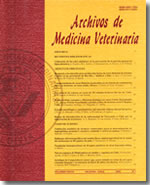Effects of apple pulp silage inclusion
Main Article Content
Abstract
The effect of including ensiled apple pulp (apple pomace) in rations of early lactation dairy cows was evaluated. Treatments were determined by three levels of apple pomace (0, 15, 30% of total intake), plus a common supply of direct-cut grass silage offered ad-libitum and a fixed amount of concentrate; protein content was the same among treatments. The study was organized in three periods of 21 days following a Crossover Latin Square design of four 3 x 3 squares (treatments x periods). Measurments were made on individual basis in the last seven days of each period, and at the end of each, cows were rotated. Standarized (4% fat) and nonstandarized milk production increased with the inclusion of apple pomace (P< 0.05); on average, supplemented cows produced 9% and 5.9% more standarized and non-standarized milk, respectively (P< 0.05). Contents of milk fat and protein were greater with the highest apple pomace supply. Dry matter (DM) intake increased proporcionally with intake of apple pomace (P< 0.05) as a result of a moderately low substitution rate (SR). SR (kg/kg) increased with apple pomace intake; corresponding SR values for medium (2.6 kg DM) and high (4.5 kg DM) apple pomace intake, respectively, were 0.45 and 0.55 kg/kg. Blood levels of ß-hydroxybutyrate (BHB) and urea were normal and fluctuated within reference values independently of apple pomace intake, however, BHB blood levels of supplemented cows were 50% lower compared to controls, suggesting reduced mobilization of body reserves. Results were coherent with a better body weight status displayed by supplemeted cows, which was positively correlated with apple pomace intake, demonstrating that inclusion of apple pomace effectively improved dry matter intake and energy balance.

